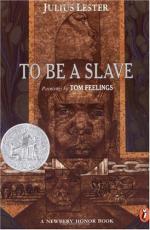
|
| Name: _________________________ | Period: ___________________ |
This test consists of 15 multiple choice questions and 5 short answer questions.
Multiple Choice Questions
1. If a slave did not have the correct weigh-in amount, what was the consequence?
(a) Being thrown in a buck.
(b) Lashes.
(c) All clothing taken away.
(d) No food for a week.
2. How did Frank Cooper realize his Mammy used to be a slave?
(a) He saw how rough her hands were.
(b) He found her freedom papers.
(c) He saw the old scars on her back.
(d) He saw the cuts on her legs.
3. In Chapter 2, who was free man who was captured and put into slavery?
(a) Ben Simpson.
(b) Solomon Northup.
(c) Lorenzo Ivy.
(d) Charles Ball.
4. What was the slave's "home" called?
(a) Slave Housing.
(b) Slave Huts.
(c) Slave Rooms.
(d) Slave Row.
5. Why did the attempt to use this first group of people for manual labor fail for the English Colonists?
(a) They were not used to plantation life and were susceptible to diseases.
(b) The language barrier proved difficult for communication.
(c) They were uncompromising and unwilling to work.
(d) They rebelled often against the landlords and ran away.
6. The slave homes of this former President was a notable exception to the norm in terms of the condition of the homes:
(a) George Washington.
(b) James Madison.
(c) Thomas Jefferson.
(d) John Adams.
7. Who told the account of a man named Gabe?
(a) Alice Johnson.
(b) Ida Hutchinson.
(c) Henry Johnson.
(d) West Turner.
8. What was the typical work hours for a slave who worked in the field?
(a) Mid-morning to midnight.
(b) Sunrise to sunset.
(c) Sunrise to midnight.
(d) Sunrise to nighttime.
9. What was it about the African civilizations that made it easier for colonists to use the Africans more easily?
(a) African civilizations were highly developed with economic and political institutions, not unlike the American's own growing economy.
(b) African civilizations encouraged traveling overseas.
(c) The African civilizations were different which made the American way more inticing.
(d) The African civilization was uncouth and therefore it was easier to teach them how to be a slave.
10. What percentage of the South owned no slaves?
(a) 50%.
(b) 60%.
(c) 25%.
(d) 75%.
11. Whose account is an example of a joyous occasion seen at the auction block?
(a) Prince Bee.
(b) Lou Smith.
(c) Doc Daniel Dowdy.
(d) Jenny Proctor.
12. Why did the attempt to use this second group of people also fail for the English colonists?
(a) They were susceptible to several diseases in the New World and many died quickly.
(b) They felt that because they too were white, that they deserved equal treatment and refused to work.
(c) They were lazy and did not do their required work well.
(d) The seven year turnover meant a continued supply of new people and they could easily run away and blend in with other whites people.
13. What was a third reason Africans appealed to the colonists as slaves?
(a) They were hard and diligent workers, they did not attempt many escapes, and they did not have to be paid.
(b) There was a never-ending supply.
(c) They were diligent workers.
(d) They were eager and willing workers.
14. Why were the Africans finally selected by the colonists to be slaves?
(a) Their skin color stood out and made it easy to find them if they tried to escape.
(b) They were easy to capture.
(c) They did as they were told, made acts of rebellion, and were willing to work hard for their masters.
(d) They were easy to convince.
15. What animals did the master who taught his son to call him "Papa" use to teach his black son and white son about brotherhood?
(a) Chickens.
(b) Goats.
(c) Pigs.
(d) Sheep.
Short Answer Questions
1. This second group of people were not slaves but rather called __________________.
2. ____________ was the practice of slave owners which resulted in more children for next generation labor and an easy way to make a profit through sales.
3. Which of the following is NOT a reason a slave owner might sell a slave?
4. Most of the time when a slave was going to be __________, he/she _____________ know about it in advance.
5. What was the reason for the months that slave traders chose to have slave coffles?
|
This section contains 719 words (approx. 3 pages at 300 words per page) |

|




